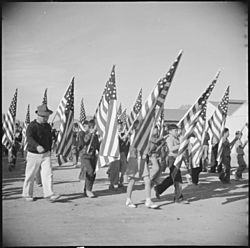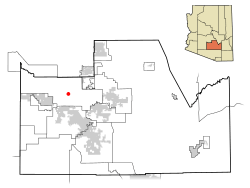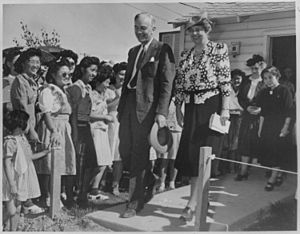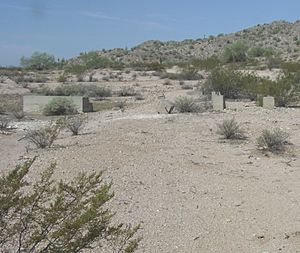Gila River War Relocation Center facts for kids
Quick facts for kids
Gila River Relocation Center
|
|
|---|---|

School children participating in the Harvest Festival Parade
|
|

Location in Pinal County and the state of Arizona
|
|
| Country | United States |
| State | Arizona |
| County | Pinal |
| Area | |
| • Total | 2.4 sq mi (6.1 km2) |
| • Land | 2.4 sq mi (6.2 km2) |
| Time zone | UTC-7 (MST (no DST)) |
The Gila River War Relocation Center was a special camp in Arizona. It was one of several camps built by the War Relocation Authority (WRA) during World War II. These camps were used to hold Japanese Americans who lived on the West Coast.
The Gila River camp was located on the Gila River Indian Reservation. This was near the town of Sacaton, about 30 miles (48 km) southeast of Phoenix. At its busiest, it had 13,348 people. This made it the fourth-largest city in Arizona at the time. The camp was open from May 1942 to November 16, 1945.
Contents
Why Were Japanese Americans Sent to Camps?
Fear and Executive Order 9066
After the attack on Pearl Harbor in 1941, many people in the United States worried about national security. There was a fear that Japanese Americans on the West Coast might help the enemy. Because of this, President Franklin D. Roosevelt signed Executive Order 9066.
This order allowed the military to create special zones. People living in these zones could be moved away if they were seen as a threat. The order did not name Japanese Americans directly. However, it was understood that it applied to them because of the war with Japan. The government was told to provide housing and food for those who were moved.
Forced Removal and Its Impact
The forced removal of Japanese Americans began in April and May 1942. Families in California, Oregon, Washington, and Arizona were given less than a week to prepare. They had to sell their homes and businesses very quickly. This often meant selling them for much less than they were worth.
After the war, many Japanese Americans had to start over. They had lost almost everything. Years later, in the 1980s, the U.S. government admitted this was a mistake. Congress passed the Civil Liberties Act of 1988. This law offered an official apology and money to those who had been held in the camps. In total, about 119,000 Americans of Japanese descent were held during World War II.
Life at Gila River Camp
Camp Location and Structure
The Gila River War Relocation Center was one of ten such camps. These camps were mostly in the western interior of the U.S. Gila River was one of two camps in Arizona. Many camps, including Gila River, were chosen for their remote, desert locations.
The Gila River camp was built on the Gila River Indian Reservation. The Pima Indian government strongly objected to this. Construction started on May 1, 1942. The camp officially opened on July 20, less than two months later.
The camp had two separate parts: 'Canal' and 'Butte'. Canal Camp closed on September 28, 1945. Butte Camp closed on November 10, 1945. The entire Gila River Relocation Center officially closed on November 16, 1945.
Who Lived There?
Most people sent to Gila River came from cities in California. These included Fresno, Sacramento, and Los Angeles. Later, about 2,000 people also came from the Jerome War Relocation Center in Arkansas when that camp closed. At its peak, Gila River was Arizona's fourth-largest city, with 13,348 residents.
Some people faced difficult conditions. The mother of Iva Toguri D'Aquino died shortly after arriving at Gila River.
Daily Life and Activities
Gila River was seen as one of the less harsh camps. It had only one watchtower, and its fences did not have barbed wire. The camp leaders tried to make life better for the residents. They allowed access to some services in Phoenix.
Gila River was one of the first camps to have a local "democratic" council. This council was made up of residents, but it was closely watched by the WRA. Only Nisei (second-generation Japanese Americans born in the U.S.) could hold positions on the council.
The camp also encouraged fun activities. These included sports and arts. Butte camp had a large baseball field that could hold 6,000 people. It was designed by Kenichi Zenimura, a professional baseball player. Residents also built a theater for plays and movies. They made playgrounds and planted trees to improve the desert landscape. Butte Hospital provided medical care for everyone.
Living Conditions
Canal Camp had 404 buildings, including 232 barracks and 24 schoolhouses. Butte Camp had 821 buildings, with 627 barracks for living. These barracks were made of wood and fireproof shingles. However, they were not very good at keeping out the desert heat.
Each barrack was meant to house four families in separate apartments. But the camp was often too full. It was designed for 10,000 people but held over 13,000. Some families had to live in the mess hall or recreation buildings. They used blankets to create makeshift walls for privacy. The camp also had problems with water shortages. Residents sometimes got bitten by venomous rattlesnakes and scorpions, keeping the hospital busy.
The Camp Today
The land where the camps were built belongs to the Gila River Indian Tribe. They consider it sacred. Public access to the old camp sites is restricted. Most of the original buildings are gone. However, you can still see things like the old road layout, concrete foundations, and small ponds.
In 2006, President George W. Bush signed a law. This law provided $38 million to help restore the Gila River center and nine other former camps. This money helps remember what happened there.
Notable People Who Lived at Gila River
Many people who were held at Gila River later became famous. Here are a few:
- George Aratani (1917–2013), a successful business owner.
- Harry K. Fukuhara (1920–2015), honored in the U.S. Military Intelligence Hall of Fame.
- Evelyn Nakano Glenn (b. 1940), a professor and founding director of a center for race and gender studies.
- Masumi Hayashi (1945–2006), a photographer and artist.
- George Hoshida (1907–1985), an artist who drew his experiences in the camps.
- Dale Ishimoto (1923–2004), an American actor.
- Yuriko Kikuchi (1920–2022), a dancer and choreographer.
- Noriyuki "Pat" Morita (1932–2005), an American actor famous for roles in Happy Days and Karate Kid movies.
- Kazuo Otani (1918–1944), a U.S. Army soldier who received the Medal of Honor.
- Paul Terasaki (1929–2016), a scientist known for his work in organ transplants.
- Kenichi Zenimura (1900–1968), a baseball player and manager.
Images for kids
See also
- Densho: The Japanese American Legacy Project
- Other similar camps:













